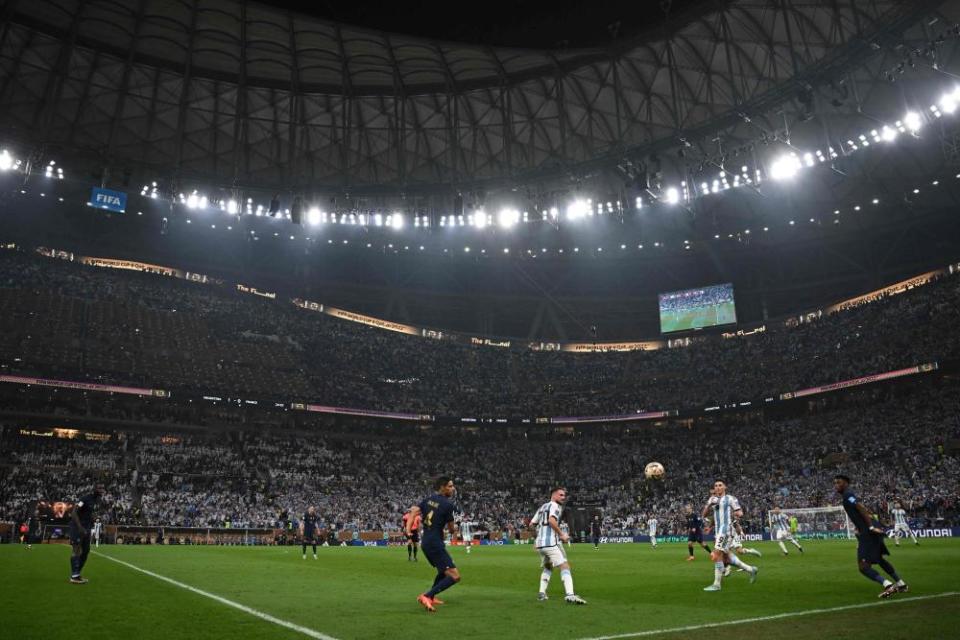Broken promises? Future of Qatar’s World Cup stadiums still up in the air
The workers’ accommodation next to Ahmad bin Ali Stadium is at least two thirds empty now. Those who remain can make the short walk from the central block to the mess room, where food and drink are available. The other two structures have virtually been hollowed out since the World Cup: one of the alleys between them is all but blocked by a pile of bedframes and mattresses, of which there are plenty because the inhabitants lived four to a room. Presumably someone, at some point, will arrive to clear up the extensive clutter; further behind is a spread of binbags and other trash. An employee estimates 100 men remain: they are contracted to the two firms who built the venue and, while the showpiece event is long gone, there is still work to be done here.
Exactly how much remains to be seen. These workers appear to be carrying out routine maintenance but, according to Qatar’s post-tournament legacy plan for the site, Ahmad bin Ali Stadium will soon be scaled back from its present 45,000 capacity to a more manageable 20,000. The removed seats in its upper tier will be donated to venues domestically and “nations in need of sporting infrastructure”; a newly compact arena will be neatly sized for domestic and continental games played by the local club, Al Rayyan.
Related: Criminal case is opened over death of migrant worker during Qatar World Cup
The question is when, exactly, any of this will happen. Qatar’s future promises for its World Cup venues appear entirely logical: they evince understanding that a tiny state should have no need for eight stadiums that each hold between 40,000 and 89,000 supporters so five of them are due to downsize and Lusail Stadium, which staged the final, is slated to be repurposed entirely. Stadium 974, partly fitted out with shipping containers, has been celebrated as the first temporary venue in World Cup history. It is to be reinstalled elsewhere: Tunisia, if you believe the word around Doha, or maybe another country in need.
It is not the best look to keep any recipients waiting. Stadium 974 was highly intact on a visit three months after the World Cup final. Similarly to Ahmad bin Ali, there was no sign of any rush to take it apart. One worker at the site speculated its lifespan will expand another “one or two years”; another assessed his own future and wondered if his contract would be renewed for the Asian Cup, which Qatar will hold early next year after stepping in when China pulled out.
No football has been played there since Brazil’s rout of South Korea on 5 December. Further out of town, Al Janoub Stadium and Al Thumama Stadium have both been used for AFC Champions League games this year. The pledge is the capacities of both will shrink from 40,000 to 20,000; the lower figure looks comfortable given the biggest attendance in those fixtures was 16,320, in a semi-final between the local side Al-Duhail and Saudi giants Al-Hilal. A source familiar with the workings of Al Janoub expressed surprise when the Guardian posited that the capacity might reduce sometime soon.
There was no sign of major structural work taking place on visits to Education City or Al Bayt, which became England’s second home last winter. The upper tier of Al Bayt is claimed to be earmarked for a hotel and mall, the 68,000 capacity being slashed as a result; Education City is to halve in size and potentially become a base for a revamped Qatar women’s team. The playing surface at Lusail, assiduously tended to, could seemingly be used this weekend if required but there is no date for its next fixture and nor is any timeline available for its transformation into a multifaceted community hub.
There is no suggestion Qatar’s plans have been shelved or will not be fulfilled. But the picture has certainly changed since June 2021, when Fifa published its Greenhouse Gas Accounting report for the tournament. The report said: “The post-tournament phase stretches from the end of the FWC [World Cup] phase to 25 June 2023. During this time, the temporary elements of the venues, such as temporary seats, the Ras Abu Aboud Stadium and the overlay infrastructure, will be demounted.”
It is clear that target has slipped dramatically. The Supreme Committee did not respond to a request for timelines around each of the stadiums with temporary elements. Fifa, though, admitted they have become fuzzy. “Given Qatar’s bids for upcoming international sport events, the final timeline for the adaptation of the World Cup stadiums is not confirmed,” it told the Guardian. “The exact timing is still to be confirmed, among others because of the said events possibly taking place in Qatar.”
The Asian Cup and the 2030 Asian Games are currently the only major events in Qatar’s calendar, although the country has been weighing up a bid for the 2036 Olympics and Fifa’s refashioned Club World Cup, which will take place quadrennially from 2025, may well be an attractive target.
Locally, the Asian Cup is cited as a major reason for Qatar’s foot-dragging over the execution of its stadium legacy. No bid had been made for that tournament when the plans were drawn up. Yet the hesitancy to put at least some of its schemes in motion appears strange given the tournament rarely attracts high attendances: during its 2019 iteration in the United Arab Emirates, an accessible regional hub like Qatar, only 24 of 51 games drew crowds of over 10,000. When Qatar last hosted the tournament, in 2011, that figure was 15 of 32. Reduced capacities would surely be adequate in most cases and Qatar has five other stadiums that can hold between 13,000 and 21,000.

Any delays also pose environmental questions. A rarely used or oversized stadium still requires electricity and water for its daily maintenance. Qatar has been assiduous in attempting to maximise energy efficiency and in its use of recycled materials. It has pledged a carbon neutral World Cup but the extent to which added emissions caused by stretched timescales will be included in post-tournament data is unclear. Fifa said: “The shortening or extension of the timeline of [the] process will not affect the organisers’ commitments in connection with carbon management as per the event’s sustainability strategy.”
While it is not the domain of Fifa or the Supreme Committee, the impact around some of the grounds’ surrounding infrastructures also appears severe. Lusail Boulevard, virtually empty on a typical non-tournament day, has around 30 scarcely used food and drink outlets along with a Sainsbury’s, fully stocked with both fresh and non-perishable products, where staff routinely outnumber customers. The construction of a futuristic new city continues apace, with accordingly hefty consumption, but it is hard to see how all the vast new developments will be populated any time soon.
Meanwhile, as Qatar decides how and when to honour its promises, the workers next door to Ahmad bin Ali dodge the rubbish and rest up for another day. They will be back tomorrow and the day after: that much is certain. Their host country, though, is offering little clarity about the implementation of its post-World Cup vision.

 Yahoo Sport
Yahoo Sport 




































































